Book Title: Jain Rup Mandan Author(s): Umakant P Shah Publisher: Abhinav Publications View full book textPage 9
________________ Jaina-Rupa-Mandana sources was remarkable. In 1887 he wrote 'On the Authenticity of Jaina traditions', in W.Z.K.M., and in 1896, a paper on "Epigraphic Discoveries at Mathura'. His 'Legend of the Jaina Stūpa at Mathura was published in German in S.K.A.W., Wien, 1897. In 1903, Burgess translated in English Buhler's paper 'On the Indian Sect of the Jainas', appending himself an 'Outline of Jaina Mythology'. J. Anderson in his Catalogue of Archaeological collections in the Indian Museum (c. 1883) noticed a few Jaina sculptures in the Museum. He had also mentioned some Jaina bronzes, of which the bronzes from Gwalior were neglected hitherto. I have recently published these Gwalior bronzes along with other Jaina bronzes from Prof. Eilenberg's collections. V.A. Smith (1901) published his 'The Jaina Stūpa and other Antiquities of Mathura', a work of outstanding value for all later studies of Jaina antiquities from Kankali Tila, Mathura. On the basis of some Canareso Dhyana-ślokas obtained from South India, J. Burgess discussed ‘Digambara Jaina Iconography' in Indian Antiquary, vol. 32 (1903-4), and illustrated various yakşas and yakşiņis with modern line-drawings. His Archaeological Survey Reports entitled 'Antiquities of Kathiawad and Kachchha' (1876), 'Report on the Belgaum and Kaladgi Districts (1874) and 'A Revised List of Antiquarian Remains in the Bombay Presidency (jointly with H. Cousens' noticed Laica su i images and shrines. Also noteworthy is his Report on the Elura Cave Temples and the Brahmanical and Jaina Caves in Western India, Archaeological Survey of Western India, vol. V (1883), as also Cave Temples of India (jointly with J. Fergusson) and Inscriptions from Cave Temples of India (with Bhagwanlal Indraji, 1881). Growse, F.S., wrote on Mathura and also discussed some Mathura Inscriptions in Indian Antiquary, vol. 6. Later J.Ph. Vogel published his famous Catalogue of the Curzon Museum of Archaeology at Mathura (1910), La Sculpture de Mathura, Art Asiatica, Paris, 1930, and wrote on the Mathura School of Sculpture in ASI, A.R., 1906-07 and 1909-10. Bhandarkar, D.R., wrote on the now famous Jaina Caumukha Temple at Ranakpur (ASI, A.R., 1907-08). In an article on Jaina Iconography (ASI, A.R., 1905-06) ho identified and described a sculpture depicting the Aśvāvabodha-tirtha and Sakunikā-vihāra story associated with the life of Tirthankara Munisuvrata, and discussed the Jaina Samavasarana in another article on Jaina Iconography in Indian Antiquary (1911). In 1915, he discovered from excavations at Vaļā (ancient Valabhi) five unique Jaina bronzes assigned to c. fifth and sixth centuries A.D., now preserved in the Prince of Wales Museum, Bombay. As Superintendent, Western Circle, he surveyed a number of sites (Jaina as well as Hindu) in Western India. Banerji, R.D., discussed 'New Brahmi Inscriptions of the Scythian Period' in Epigraphia Indica, X (1909-10) and described some Jaina images and pedestals. In his notes on Mangya Tungya Caves (ASI, A.R., 1921) he described some early mediacval Jaina carvings in Maharashtra. In his Eastern School of Mediaeval Indian Sculpture he discussed Jaina images discovered from Bengal; in his Age of the Imperial Guptas he discussed some known Jaina sculptures of the Gupta Age. In 1914, Dr. A.K. Coomaraswamy opened a new line of studies in his 'Notes on Jaina Art' wherein he discussed miniature paintings of the Kalpa-sútra, a cosmographical chart and a canvass pața of Pārsvanatha. In his Catalogue of Indian Collections in the Museum of Fine Arts, Boston, vol. IV, Jaina Paintings, 1924, he described Jaina miniature paintings, Jaina Jataka-scenes. He also discussed iconography of Tirtbaðkaras, deities like Indra, Naigamesa and others and described the five kalyäpakas in the life of each Tirthaokara. In his Boston Catalogue, vol. IV, in the Portfolio of Indian Art and in his History of Indian and Indonesian Art he published some i Jaina sculptures and temples. In 1935 was published his beautiful paper on "The Conqueror's Life in Jaina Painting" (JISOA, vol. III) wherein he tried to interpret the fourteen prognostic dreams of a Jina's mother. His remarkable pioneer study of Yaksas (parts I and II) (1928-31) has been largely helpful in our study of Yakşas and Yaksinis in Jaina art and literature. Two monumental studies by H. Cousens, entitled 'Chalukyan Architecture' and 'Antiquities of Somnath and Kathiawad', were very useful in our study of Jaina antiquities in Karnataka and Kathiawad. His studies of shrines at Aihole, published in ASI, A.R., 1907-08, were equally illuminating. Jain Education International For Private & Personal Use Only www.jainelibrary.orgPage Navigation
1 ... 7 8 9 10 11 12 13 14 15 16 17 18 19 20 21 22 23 24 25 26 27 28 29 30 31 32 33 34 35 36 37 38 39 40 41 42 43 44 45 46 47 48 49 50 51 52 53 54 55 56 57 58 59 60 61 62 63 64 65 66 67 68 69 70 71 72 73 74 75 76 77 78 79 80 81 82 83 84 85 86 87 88 89 90 91 92 ... 466
